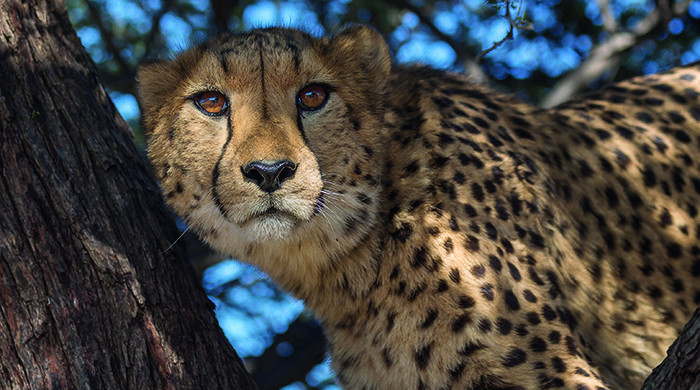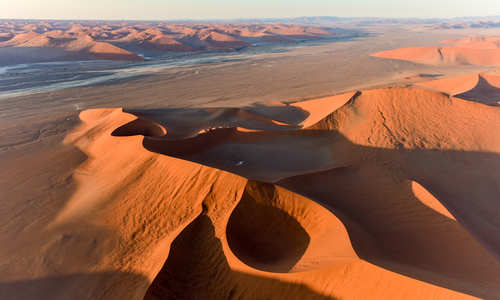Article content
1 April 2020
Wexas Honorary President Jonathan Scott goes in search of cheetahs in the deserts of Namibia.
Pictures by Jonathan & Angela Scott (originally published in 2015)
Namibia is like no other country in Africa, a desert land the size of Britain and France combined. When I think of Namibia, I think of the ravishing pastel colours of the Namib desert, with the towering dunes at Sossusvlei washed a surreal orange and brown, soaring knife-edged to 300 meters against the bluest skies on earth. Tucked away in the depths of the dunes is a place called Dead Vlei, where the sculpted bones of 800-year-old trees create a photographer's playground, on a mosaic of rock-hard white ground with the sun-washed red of the dunes as backdrop.

To really appreciate the beauty of Namibia, you need to fly over its dunes and along its sparkling coastline of diamonds and shipwrecks in a light aircraft - or in a hot air balloon, as we did early one morning for an hour on an aerial adventure that quite simply took our breath away, while staying at Sossusvlei at Wilderness Safaris' Little Kulala. But if the idea of a sparsely populated wasteland of dunes and rugged mountains fails to capture your imagination, then spending time with the Himba cattle people along the Kunene River, on Namibia's northern border with Angola, will soon have you reaching for your camera again. The Himba surely rival the Masai of East Africa for the title of most photogenic nomads, seemingly unfazed by the blistering heat of their homeland, with statuesque womenfolk adorned in glistening red ochre, long braided hair and tunics of cow skin.
Namibia is not a wildlife destination to compare with the super-abundance of Kenya's Masai Mara Game Reserve or Tanzania's Serengeti National Park. But then where is? Botswana's Okavango Delta perhaps? Yet Namibia is home to Africa's largest cheetah population, with perhaps 3,000 of these elegant spotted cats roaming the vast cattle farms and game ranches that dominate the rural landscape.

Worryingly, not so long ago you heard talk of 12-15,000 cheetahs scattered across Africa, all of them as closely related as brothers and sisters due to inbreeding. This worrying trend was thought to have been caused by a crash in the worldwide cheetah population 10,000 years ago, with a further bottleneck little more than a 100 years ago brought about by pressure from livestock farmers and the trade in spotted cat skins.
But today it isn't inbreeding that threatens the cheetah. It is the trade in live cheetahs, along with conflict with livestock owners and loss of natural prey and habitat. Approximately 90 per cent of the cheetah population has vanished in the last 100 years, and figures of less than 10,000 individuals are being spoken of. A particular concern today is the trade in skins and live cheetah cubs from the Horn of Africa to the Middle East.
Cheetahs are notoriously difficult to breed in the wild, hence the demand for young wild-bred cheetahs. These are transported by boat from Somalia to the Yemen, and then by road to the Gulf States including Saudi Arabia, to supply the lucrative exotic pet market there. In Arab countries, the cheetah is considered the ultimate exotic house pet.

Over half the animals being smuggled are estimated to die en route. Qatar, the Emirates and Kuwait have all recognised the seriousness of the problem and are committed to curbing the trade through better law enforcement. Elsewhere, the Iranian cheetah - the most threatened sub-species - now numbers just 40-100 individuals. Cheetahs in north and west Africa number fewer than 250, and are threatened by the demand for skins for clothes, and bones and body parts for traditional medicine and magic rituals.
Namibia might be a desert land, but its robust network of all-weather roads reach out to all corners of the country, making this a paradise for self-drive enthusiasts. We made two safaris to Namibia this past year, and on each occasion made sure to visit the Cheetah Conservation Fund's (CCF) headquarters, a comfortable four-hour drive north of the capital city, Windhoek.
The dynamic founder of CCF, Dr Laurie Marker, left her home in the USA 25 years ago, after helping to establish the most successful captive cheetah-breeding program in North America during her 16 years at Oregon's Wildlife Safari facility in the 1970s and '80s. Having first visited Namibia in 1977, Dr Marker realised that the priority had to be saving cheetahs in the wild. She embarked on a one-woman campaign to combat the killing of cheetahs by Namibia's farmers and game ranchers, who had already shot, trapped and poisoned other large predators such as lions, leopards and hyenas living on their land. The cheetah suddenly found itself the top cat.

It is not uncommon for a cheetah to give birth to up to six cubs in the wild. (The record is ten cubs, recorded in Nairobi National Park, though the mother was forced to abandon her cubs at three months of age because she simply could not cope.) The majority of cheetah cubs do not survive the first few months of life, in places like the Masai Mara and the Serengeti, due to the high density of lions and hyenas. But freed from the competitive pressure of other large predators, cheetahs soon began to thrive on the ranch lands. Now their greatest threat is humans.
Famers and game ranchers routinely set live traps at the base of the thorn trees that cheetahs favour as scent posts, capturing and killing hundreds of animals. Dr Marker came up with a plan of action to try to work with the ranchers and small-stockholders among the rural community, to encourage better animal husbandry instead of killing any cheetah they came in contact with. This included encouraging them to build more robust livestock enclosures and to practice seasonal calving in stockades (rather than letting cows calve out in the bush all year round). One of CCF's most innovative initiatives has been the breeding of Anatolian guard dogs to help protect livestock from predators. CCF breeds and trains guard dogs that bond as puppies with the livestock they are entrusted to care for, and this has proved highly effective at deterring attacks from predators.


